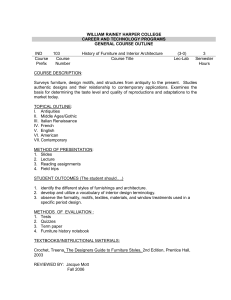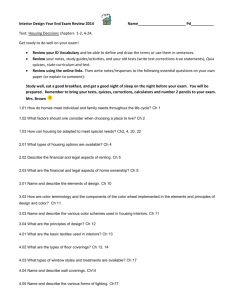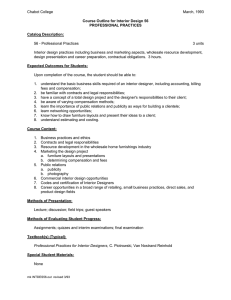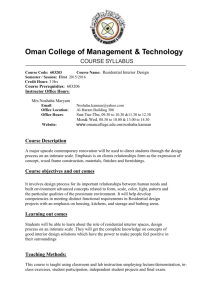WILLIAM RAINEY HARPER COLLEGE CAREER AND TECHNOLOGY PROGRAMS GENERAL COURSE OUTLINE
advertisement
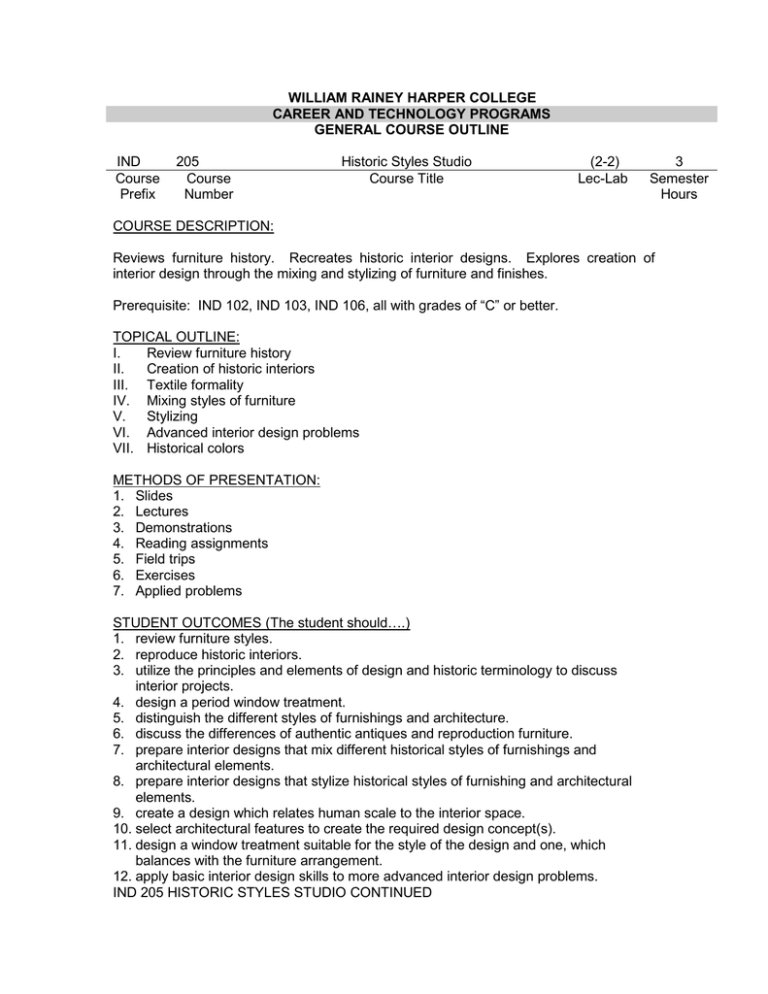
WILLIAM RAINEY HARPER COLLEGE CAREER AND TECHNOLOGY PROGRAMS GENERAL COURSE OUTLINE IND Course Prefix 205 Course Number Historic Styles Studio Course Title (2-2) Lec-Lab 3 Semester Hours COURSE DESCRIPTION: Reviews furniture history. Recreates historic interior designs. Explores creation of interior design through the mixing and stylizing of furniture and finishes. Prerequisite: IND 102, IND 103, IND 106, all with grades of “C” or better. TOPICAL OUTLINE: I. Review furniture history II. Creation of historic interiors III. Textile formality IV. Mixing styles of furniture V. Stylizing VI. Advanced interior design problems VII. Historical colors METHODS OF PRESENTATION: 1. Slides 2. Lectures 3. Demonstrations 4. Reading assignments 5. Field trips 6. Exercises 7. Applied problems STUDENT OUTCOMES (The student should….) 1. review furniture styles. 2. reproduce historic interiors. 3. utilize the principles and elements of design and historic terminology to discuss interior projects. 4. design a period window treatment. 5. distinguish the different styles of furnishings and architecture. 6. discuss the differences of authentic antiques and reproduction furniture. 7. prepare interior designs that mix different historical styles of furnishings and architectural elements. 8. prepare interior designs that stylize historical styles of furnishing and architectural elements. 9. create a design which relates human scale to the interior space. 10. select architectural features to create the required design concept(s). 11. design a window treatment suitable for the style of the design and one, which balances with the furniture arrangement. 12. apply basic interior design skills to more advanced interior design problems. IND 205 HISTORIC STYLES STUDIO CONTINUED 13. draw furniture in plan & elevation, which accurately represents the piece. 14. achieve good drafting & design skills and produce floor plans, elevations, prints of drawing(s), board presentation(s) and title blocks. 15. use multiple line weights or thicknesses to clarify the drawings. 16. select and combine furniture of proper scale and formality, color, scale, and pattern to meet client preferences, ensure a workable environment, and create a welldesigned interior. 17. balance a space and presentation board or drawing, visually through the proper use of scale and mass of furniture, color, pattern, placement, accessories, window treatments, and placement of written information. 18. experiment with different lettering options, i.e. hand lettering, computer lettering, label machines, press type. 19. utilize hand-drafting and lettering skills using various line weights of pencil lead and various thicknesses of ink on mylar and paper. 20. draw furniture in elevation, which is on angle in plan view. 21. prepare space plans with proper clearances. 22. analyze space planning through traffic patterns and functional relationships. 23. apply the principals & elements of design to an interior space and utilize these to discuss interior projects. 24. create harmonious designs within the parameters of the space and client program requirements. 25. incorporate the client’s needs, personalities & preferences into the interior design solution. 26. write a design concept. 27. give verbal presentation(s) of the design project(s), which identify how the project(s) meet(s) the client’s needs. 28. participate in classroom discussions and critiques. 29. utilize interior design resources, i.e. periodicals, books, catalogues, Internet research. METHODS OF EVALUATION: 1. Applied problems with grade sheets 2. Group critiques 3. Individual consultation TEXTBOOKS/INSTRUCTION MATERIALS: Miller, Judith, and Lindley, David, Furniture, 2nd edition, Dorling Kindersley Publishing, 2006 Blakemore, Robbie G, History of Interior Design & Furniture, 2nd Edition, John Wiley & Sons, 2006 REVIEWED BY: Jacque Mott Fall 2006
